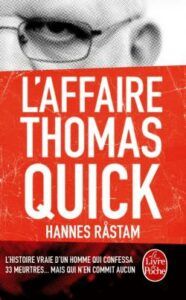The Case of Thomas Quick by Hannes Rastam
The Thomas Quick case is a true story. It is a documentary book that traces the journey of journalist Hannes Råstam in his investigation of Thomas Quick.
Synopsis
In the 1990s, Thomas Quick was convicted of eight murders and confessed to twenty-five others, committed between 1964 and 1993. He was considered the most ruthless rapist, cannibal and serial killer in Scandinavian history. In 2008, the journalist Hannes Råstam visited him in the psychiatric hospital where he was confined for life. He then collects documents related to the investigation, dissects the interviews and statements of Quick, studies the verdicts, reconstructions of the crimes.
He then discovers the unthinkable: Thomas Quick is a mythomaniac, but not a criminal. How can a harmless pretender, without evidence or witnesses, be accused and convicted ? Since the publication of this book, Thomas Quick has been acquitted, then released in 2014.
Review
 The book has had rave reviews. The work of the journalist is so immense. It is a long term investigation that we can only admire.
The book has had rave reviews. The work of the journalist is so immense. It is a long term investigation that we can only admire.
The story is worthy of a Hollywood movie. But its veracity gives us a chilling journey.
From the beginning, we get lost in the middle of the two camps of the investigation: those who are convinced that Thomas Quick is a cruel and ruthless killer, and those who see the gaps and inconsistencies of the investigation.
What is very interesting is that the author manages each time to make us swing in one camp or the other to finally take us where he wants and prove his hypothesis.
The mythomania, a serial killer not guilty, these themes are generally not discussed in cinema. Indeed, one remembers especially the "real" ones such as Hannibal Lecter for the fiction or Ted Bundy, for the reality. These characters are far more fascinating. But you would think that a man who has confessed to dozens of murders, but committed none, would be just as fascinating, and yet he is the real Thomas Quick;
Through his investigation, the journalist gives us a glimpse of the real Thomas Quick, a man addicted to narcotics, who understood that by confessing to crimes, he would be looked at. But, this explanation makes the story less interesting. This may be a true story, but it is the facts and only the facts that are told.
A feeling of going in circles is sometimes felt.
If the subject promises twists and turns and can be read as a thriller, this is not the impression I got from it. Indeed, the style is quite different from a classic thriller. The rhythm is slow and it is sometimes difficult to enter the story.
The author has kept a journalistic style, rather cold and distant, which prevents us from identifying ourselves and fully adhering to his investigation.
Nevertheless, I have no doubt that the Thomas Quick case will be exciting for psychologists, lawyers and of course journalists. Find this book by clicking here.